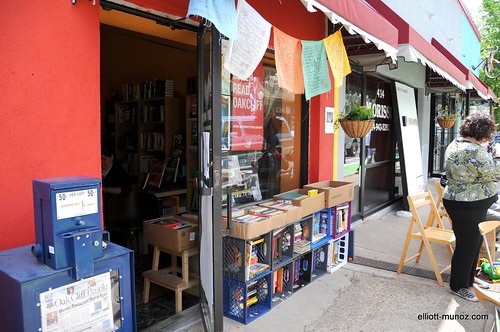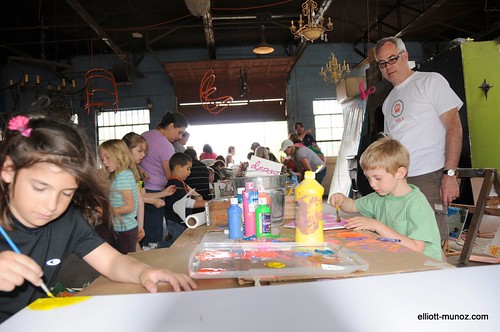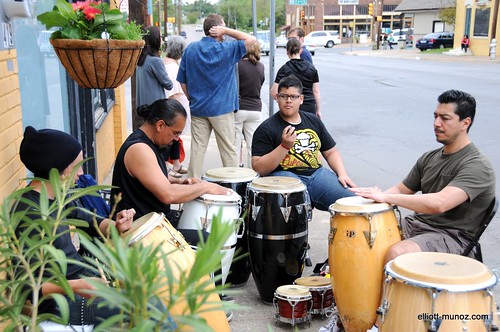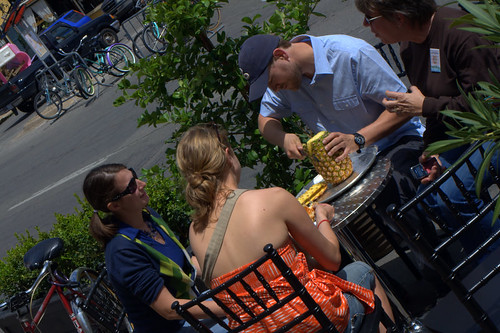HOW TO BUILD A BETTER BLOCK
The Better Block project started in April, 2010, when a group of community organizers, neighbors, and property owners gathered together to revitalize a single commercial block in an underused neighborhood corridor. The area was filled with vacant properties, wide streets, and few amenities for people who lived within walking distance. The group brought together all of the resources from the community and converted the block into a walkable, bikeable neighborhood destination for people of all ages complete with bike lanes, cafe seating, trees, plants, pop-up businesses, and lighting. The project was developed to show the city how the block could be revived and improve area safety, health, and economics if ordinances that restricted small business and multi-modal infrastructure were removed. Since that time, Better Block projects have been developed throughout the nation with many of the temporary infrastructure improvements and businesses made permanent.
The Better Block is an open-sourced project that is free to re-use and build upon. This site is developed to provide help for communities who wish to build their own Better Blocks complete with news, tools, and other resources anyone may need to help rapidly revitalize neighborhoods.
We’ve found it’s best to address the following four areas when developing a Better Block, which we will break down in greater depth:
- Safety
- Shared Access
- Stay Power
- 8-80 Amenities
Safety (Real and Perceived) – First and foremost, if an area feels unsafe then everything breaks down. Whether it be businesses, schools, or neighborhood revitalization, the key to changing a place is addressing its perceived safety. When approaching blocks, we ask the questions:
- Does it feel safe to cross the street?
- Does it feel safe to stand on the sidewalk?
- Does it feel safe to linger in the area?
- Does the area have hidden corners or large obstacles that reduce open sightlines?
- Is there area filled with debris, graffiti, overgrown landscaping, etc.?
- Do the businesses have bars on the windows or opaque windows?
Our goal is to address each of these questions and find ways to improve the area rapidly.
Shared Access – The next goal we focus on is looking at ways to bring more people into the area by various modes of transportation. We ask the questions:
- Do pedestrians have easy and clear access to the area?
- Do bicycles feel welcome in the area?
- Is the area easily accessible from neighborhoods?
- Are there way finding signs that direct people into and out of the area?
- Are there amenities that allow people to linger in the space (seating, tables, etc.)?
Stay Power – How can we encourage people to visit the area and have them linger, and invite their friends?
- Are there food options on the block?
- Are there places to eat outdoors?
- Are there maps, bulletin boards, games, or other amenities that encourage people to linger?
- Is the identity of the area prominent (arts district, cultural district, historic area)?
8 – 80, dog-owners - Lastly, we look at amenities that create invitations for children, seniors, and dog owners on a block. These groups tend to be indicators of a healthy environment that feels welcoming and attracts other people.
Next steps:
Preview the area for best possible Better Block locations. We’ve created a quick survey that helps us identify strong candidates.
Ideally, locations with a block of buildings that have good pedestrian form, but lack a complete street are preferred, but we’ve developed Better Block projects in areas that failed to meet much of the criteria identified in the survey. It’s still possible, but the project will only be as successful as the community you partner with. Typically areas built pre-war have good possibilities. Also, review former streetcar intersections at your local library to help identify small commercial corridors that are nestled into neighborhoods. Proximity to a neighborhood is the most important factor when putting together a Better Block.
Create a free wordpress.com or blogspot.com site to provide the community information on the project. Also, create a facebook event so others can “Like” the project and begin forwarding details to your contacts within the community.
Post your event on the Better Block Group Map. We’ve setup a collaborative map for anyone interested in developing a Better Block project here. Pin the block you want to repair and be sure to provide links so others can take part.
Assemble team of grassroots community activists, non-profit groups, businesses, artists, and DIY’ers. College students, urban planning/architect associations, young business professionals, and local Etsy groups have been some of our strongest partners for Better Block projects.
Latch the Better Block to an existing event, such as an art crawl, ciclovia, fun run, et cetera. More than likely, the area you’re revitalizing has been offline and most residents don’t know to return to the area. We’ve developed food events, bike rides, and more that celebrate a communities identity while aligning the effort with a Better Block area.
Work with area property owners to allow access to vacant spaces for a weekend. We pitched the event as a giant “art installation”, so the vacant spaces become defacto art galleries. Our property owners were excited to freely allow access because we were actively marketing their properties. Also, immediately following our original better block, several of these vacant spaces were leased.


Create groups to develop and install temporary “pop-up” businesses to show the potential for what could be if the street had a more inviting presence. Also, try and keep in mind all users (young, old, et cetera). We installed a cafe with outdoor seating to highlight the ability to re-utilize the space given to cars. We also created a kids’ art studio so families could be involved, and a flower/gift market filled with local craft goods. You could also do a bookdrive collection, and create your own small bookstore as well with what is collected. You don’t have to get overly elaborate with your product offerings. For cafes, coffee out of pump urn is simple, inexpensive, and can create an inviting experience. If possible, work with existing local businesses to help fill the storefront with product. The goal should be place as many local products as possible in each of the shops.

Include as many people-friendly aesthetics. We’ve worked with local props warehouses to bring in planters to help divide the street, and temporary street lighting. You can also build your own planters and sandwich boards from old pallets. We’ve strung simple bailing wire between buildings at 15′ high (above a semi-trucks lowest clearance), and attached recycled christmas lights to help provide more ambiance.

Paint your own bike lane. You can use a lime green paint in the typical parking area and paint a 5′ stripe. It’s also good to add a 2′ buffer zone (painted white diagonal lines) to allow for adjacent parking/door zone clearance. White duct tape works extremely well as a replacement for paint. Also, we’ve mixed our own removable paint using equal parts flour, corn starch, and water which quickly dissolves at the end of the project.

Invite artists to perform in the street. Music is a key component to having an exciting street. Use a guitar amplifier and playing tracks from an iPod, or inviting DJ’s, drum circles, et cetera are simple ways to bring a soundscape to the block.

- Remember that people want a reason to stay and be apart of the environment. Be sure to provide plenty of seating, things to read (maps, build simple kiosks to use as community boards, food/drink). Chess boards, et cetera. Print out and post the story of the block (its history, its present, its future as a neighborhood place).
- Promote throughout the neighborhood, city, and more. Send fliers to local universities, schools, and more.
- You’ll more than likely need a permit to close a portion of the street. We specifically asked to allow one lane of vehicle traffic so that residents could see that a “complete street” that allowed all modes of transit was a viable solution. Had we simply blocked off the entire street, the message would not have been conveyed as well.
- Insurance – Often times, property owners will ask for insurance before allowing access to their buildings. We take out simple “Block Party event” insurance policies and add property owners as “additional insured” for our projects.
- Invite your Mayor, council members, city staff, so they can see the possibilities for themselves. Be sure to track sales to show the increase in area business (potential for increased tax revenue is a city’s largest motivator for change), and spotlight how traffic slows but people still have easy access and come out. We will be releasing a handful of tools shortly to help with analytics for your project. Check back soon!
- Lastly, have fun! Remember that if you want creativity, take away a zero from your budget. Often times groups get stifled by the lack of funds, but since the project is a demonstration, you can often borrow the majority of the items needed for the project. If funds are definitely required, use indiegogo.com to setup a crowdfund to help with the effort.
View the following video of our first Better Block project:
No hay comentarios:
Publicar un comentario